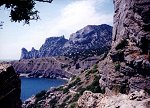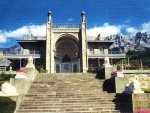[ Black Sea ] [ Climate ] [ Caves ] [ Archaeology ] [ Religion ] [ History ] [ Tourist Info ] [ Palaces ] [ Tourists' Comments ] [ Crimea ] [ Wines ] [ Meet our Team ] [ Services and Prices ] [ Mountains ] [ Hiking Trails ]
CRIMEAN PENINSULA : HISTORY
"Many things are buried in this stony ground : the sculls of the Huns, Roman tombstones, French cannon-balls, and the bones of the sailors of the Potemkin battleship who were shot..."
(K. Paustovsky)
The Crimean Peninsula is a golden prize, that has always been difficult to control. A land Bridge merging East and West, it was fought over for hundreds of years by numerous nations. But it was Russia that eventually wielded the firmest fist. Today, although officially a part of Ukraine the language you will hear is Russian.
Ancient Greek City Chersonesus.
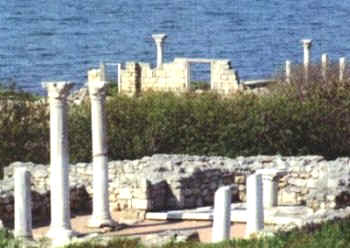 The ancient Greeks established colonies on the Crimean coast in the 6th century B.C. Excavations began more than a hundred years ago and continue today. The ancient Greeks established colonies on the Crimean coast in the 6th century B.C. Excavations began more than a hundred years ago and continue today.
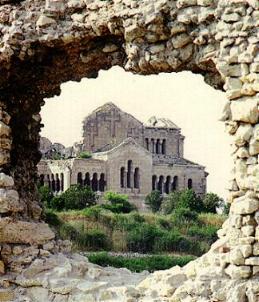 Founded in 422 BC, Chersonesus witnessed wars, trade based prosperity, absorption into the Roman then Byzantine empires, nomad attacks, and capture in 988 AD by Volodimir of Kiev. The town was finally ruined by the Tatars in the late 14th century. Founded in 422 BC, Chersonesus witnessed wars, trade based prosperity, absorption into the Roman then Byzantine empires, nomad attacks, and capture in 988 AD by Volodimir of Kiev. The town was finally ruined by the Tatars in the late 14th century.
Buried treasure of Scythians.
 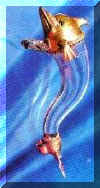 The Greeks set up colonies on the Crimean coast at roughly the same time as the Scythians. The Scythians arrived from the east, during the 8th to 6th centuries B.C. They coexisted for many centuries, until Scythian's state disappeared in the 3rd or 4th century AD. The Greeks set up colonies on the Crimean coast at roughly the same time as the Scythians. The Scythians arrived from the east, during the 8th to 6th centuries B.C. They coexisted for many centuries, until Scythian's state disappeared in the 3rd or 4th century AD.
From that time, the Crimea was the scene of continual struggle. The Greeks, Persians, Romans, Goths, Huns, Genoese, Venetians, Byzantines, and other races succeeded one another in control at intervals of a century or two.
Romans in the Crimea.
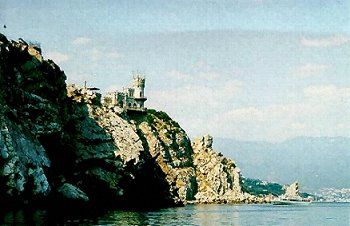 Two thousand years ago Romans sailed these waters that are visited each year by numerous tourists today. A small castle "The Swallow's Nest" on the very edge of a rocky cape Ai-Todor is a symbol of the Crimea now. It was built in the beginning of the 20th century on the same cape where Romans built their fort. Ancient
roads built by Romans, still take hikers from the coast to the mountain plateau. Two thousand years ago Romans sailed these waters that are visited each year by numerous tourists today. A small castle "The Swallow's Nest" on the very edge of a rocky cape Ai-Todor is a symbol of the Crimea now. It was built in the beginning of the 20th century on the same cape where Romans built their fort. Ancient
roads built by Romans, still take hikers from the coast to the mountain plateau.
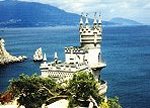
During the succeeding centuries the Crimea was overrun or occupied successively by the Goths (A.D. 250), the Huns (376), the Khazars (8th century), the Byzantine Greeks (1016),the Kipchaks (1050), and the Mongols (1237).
Medieval "Cave towns"
The cave towns were built in the 6th-10th centuries by the multiethnic populations which lived there. Cave towns are part of a defense structure enclosed with powerful fortification walls with towers, caves, impregnable casemates and natural obstacles such as abrupt forbidding cliffs. In ancient times, it was dangerous to live in fertile and convenient valleys, since the Crimean peninsula suffered from the constant raids of nomadic tribes. The caves contained also monks cells, churches, sacristies, burial vaults and other cult and husbandry premises.
Italians in the Crimea.
In 14-15 centuries the Crimea was an important point on the trade way to the Eastern countries as India and China. In the 13th century the Genoese destroyed or seized the settlements which their rivals the Venetians had made on the Crimean coasts, and established themselves at Evpatoria, Balaklava, Sudak, Feodosia, flourishing trading towns.
The City of Sudak, at the base of a shallow bay, is about 125 km northeast of Yalta. It was one of the main Genoese trading centers on the Great Silk Road. In the 14th and 15th centuries they built an enormous fortress with a series of walls and towers snaking along a massive cliff perched out over the sea.
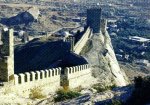 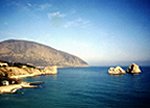

After the invasion of the Crimea by the Golden Horde forces in the 1230s, the Genoese began paying tribute to the new rulers and were allowed to maintain their colonies along the coast. In 1475 all Genoese forts were captured by the Turkish ( Ottoman) Empire.
Tatar Khanate and
Ottoman Empire
Meanwhile the Tatars (Tartars) had got a firm footing in the northern and central parts of the peninsula as early as the 13th century. Tatars moved to the Crimea with the Mongols and other Turkish groups (Khazars, Petchenegs, and Kipchacks) who had settled in eastern Europe as early as the 7th century.
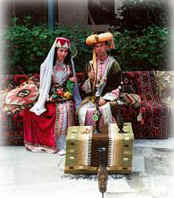 Following the disintegration of the Golden Horde, Crimean aristocrats established their own Khanate under the leadership of Haci Giray in the 1440s. Following the disintegration of the Golden Horde, Crimean aristocrats established their own Khanate under the leadership of Haci Giray in the 1440s.
However, the young Khanate became subject to the Ottoman rule in 1475, following the capture ofthe Genoese ports on the Crimean coast by the Ottoman (Turkish) naval forces.
In the next three hundred years, the Crimean Khanate remained an important political power in eastern Europe, continuing to raid Moscow and making alliances with Poland, Lithuania, and Sweden. The Ottoman influence on the Crimean society was profound.
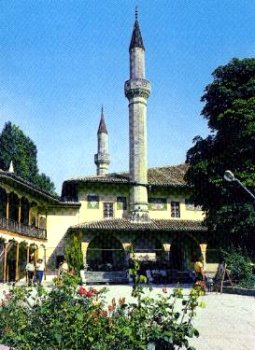 Early political conflicts within the ruling Giray family were often settled by the appointment of the Khan by the Ottoman court in Istanbul, and in the 16th century Ottoman appointments became a standard policy. Early political conflicts within the ruling Giray family were often settled by the appointment of the Khan by the Ottoman court in Istanbul, and in the 16th century Ottoman appointments became a standard policy.
The Russian Empire annexed the peninsula in 1783 following success against the Turks.
After the Crimean War of 1854-56, and in the first years of the 20th century, the Tatars emigrated in large numbers to the Ottoman empire.
Crimean War (1854-1856)
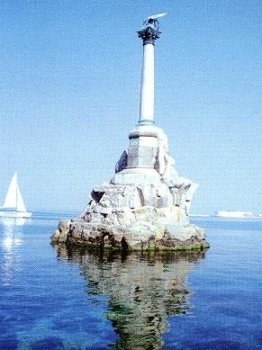 Monument to the scuttled ships, a symbol of battle glory of sailors and heroic past of Sevastopol. Monument to the scuttled ships, a symbol of battle glory of sailors and heroic past of Sevastopol.
This War was fought between Russian forces and the armies of France, England, Sardinia, and Turkey. The chief cause of the war was the ambition of Russia to gain an outlet to the Mediterranean through the Straits, held by Turkey. The key to this outlet was Constantinople.
Russian troops were driven out of Turkish territory and pursued to the Crimean peninsula. Chief battles were at the River Alma, at
Balaklava, and Sevastopol.
The charge of the British Light Calvary brigade at Russian artillery resulted from misunderstood commands at the battle of Balaclava (October 1854).
 "Panorama" is a museum of the heroic siege of Sevastopol in 1854-55. "Panorama" is a museum of the heroic siege of Sevastopol in 1854-55.
The large harbor of Sevastopol made it the most important naval base on the Black Sea. The 11 month siege of the city in 1854 and 1855 marked the chief battle of the Crimean War. Allied with the Turks Britain and France took Sevastopol after a siege against the courageous Russian Army.
Each side lost an estimated 250.000 in the war.
Sevastopol was attacked again in World War II. The second, eight month siege reduced the city to ruins. German troops occupied the peninsula from 1941 to 1944.
After Sevastopol was recaptured, it has been largely rebuilt.
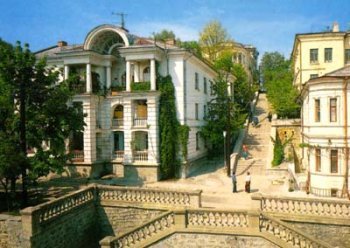 Streets of Sevastopol today. Streets of Sevastopol today.
The historical Livadia
Palace.
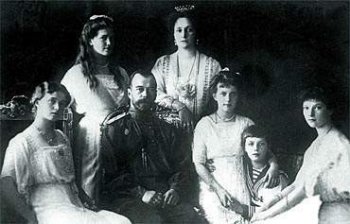 
It was Livadia, three km west of Yalta, that put the Yalta area on the maps of
both Russia and the world.
First in 1860 when the imperial family started building here, then in
February 1945 when Josef Stalin, Franklin D. Roosevelt and Winston Churchill
held their Yalta Conference in the Livadia palace.
Built
in 1911 as a summer residence for Nicholas II, it replaced earlier royal
dwellings and used much white Crimean granite in the process. It is built in
Italian Renaissance style with beautiful Florentine and Arabic courtyards.
After the revolution in which he was dethroned, Nicholas asked to be allowed
to live in Livadia as an ordinary citizen, giving up all other possessions. He
was denied this request, and assassinated along with his entire family.
After the revolution, the palace became the sanatorium.
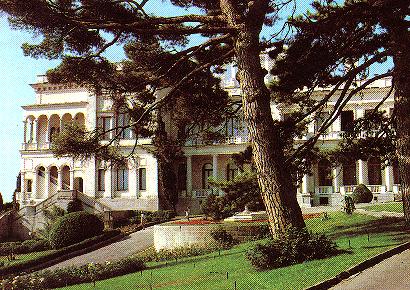 Livadia Palace was also the host site for the historical "Yalta
Conference" between Churchill, Roosevelt, and Stalin. Livadia Palace was also the host site for the historical "Yalta
Conference" between Churchill, Roosevelt, and Stalin.
It was here, that the first steps were taken to establish the United Nations.
Stalin placed his guest in two of the most beautiful palaces in Crimea.
For convenience, because of his disability, Roosevelt stayed in Livadia while
Churchill was lodged in Alupka for its English style and atmosphere.
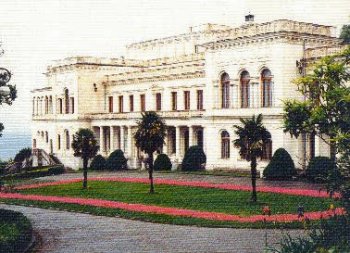
Today the palace houses the Historical Museum and Picture Gallery. The Livadia
Palace has been beautifully preserved, and holds a great fascination for tourist
today. There is a wonderful restaurant near the palace, and a beautiful Orthodox
church on the immediate grounds.
The palace has a lovely large gardens, a highlight of which is the
"sunny path", running about a mile west from just below the palace to
a lookout over resort area "Oreanda".
_______________________________________________________________________________________________________________
In the civil war that followed the Russian Revolution, the Crimea was one of the last areas to give in, holding out until 1920. In World War II, it suffered a three year German occupation and lost nearly half its population. Stalin then deported the remaining Tartars. In 1954 Khrushev transferred legislative control of the Crimea to Ukraine.
| 

